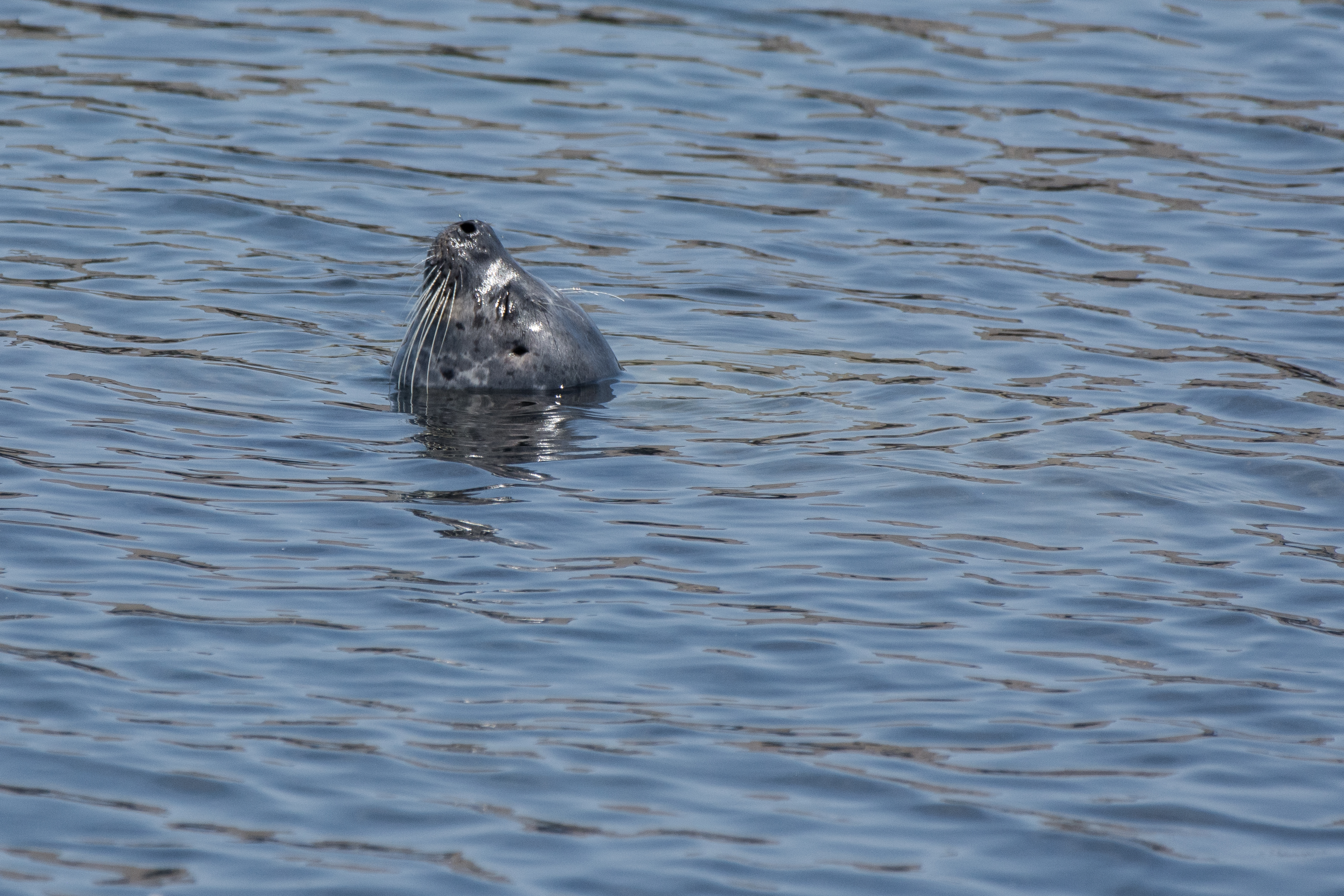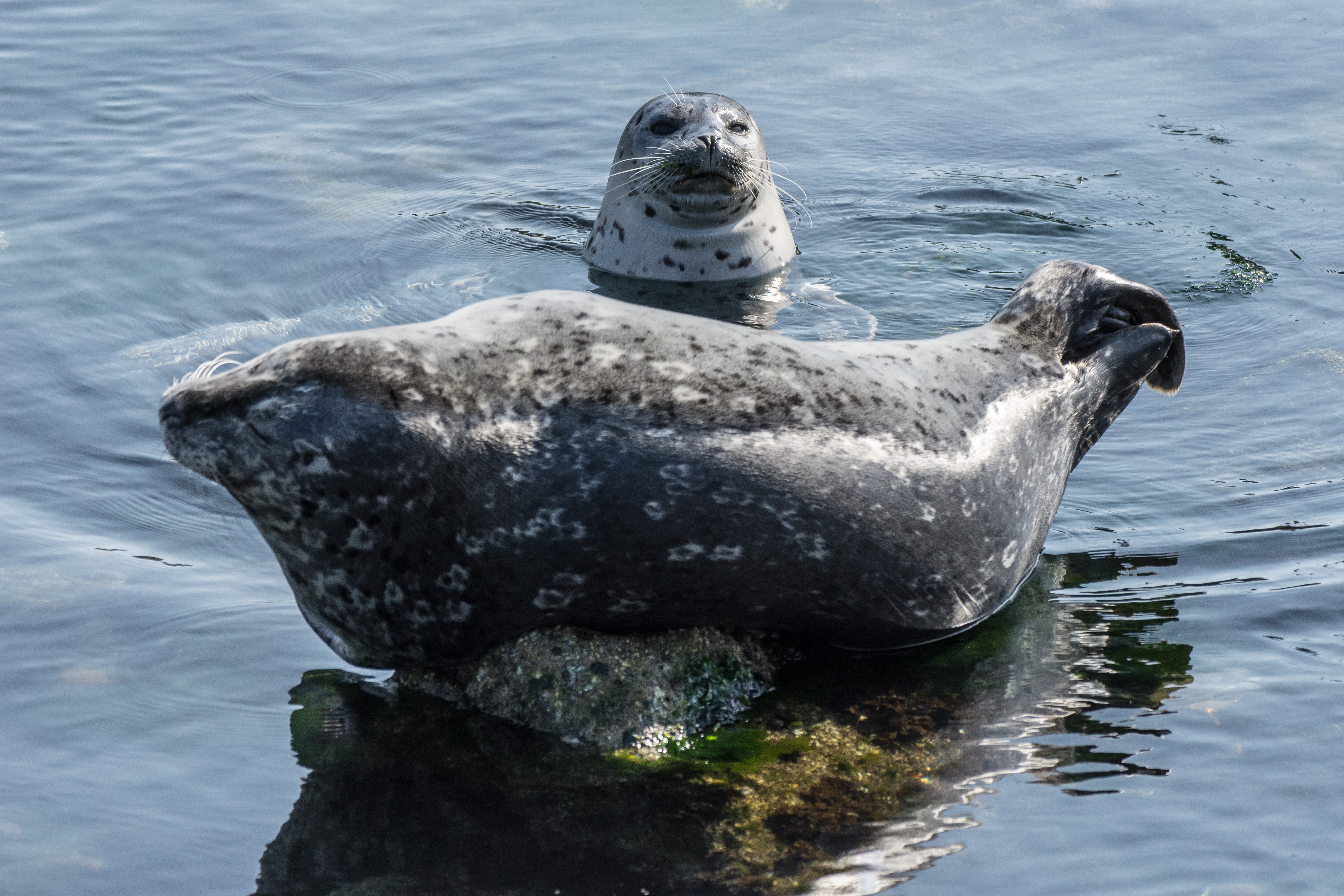The waters of Monterey Bay are a veritable stew of wildlife. The great and the good of marine biodiversity swim these waters and crawl the shores. For wildlife lovers it is one of the most joyous places on Earth. In the company of leviathan whales and frolicking Sea Otters, rambunctious California Sea-lions and peculiar pelicans, it is easy to look past the common old Harbour Seals.

When walking down to Monterey Harbor the first sound that can be heard is the braying of the California Sea-lions, but often the first creatures that you meet are quiet sunbathing beauties that are the Harbour seals. As the tide falls, the seals haul up on to any exposed rock where they enjoy the warming rays of the California sunshine.

I headed down to Fisherman’s Wharf early in the morning in readiness for a day of whale watching out in the deep waters of the bay. It was low tide, and I was greeted by a gathering of portly pinnipeds balanced like huge marble boulders on the barnacle encrusted rocks. A fantastic way to start a day of searching for marine mammals.

The seals are easy to find. There are a few spots where I always encounter them, across multiple visits to Monterey. They take possession of the rocks in the shallow sheltered harbour, leaving the breakwater and the ocean facing jetties to their noisy sea-lion cousins.

Although the Harbour seal lives a solitary life compared with the pack-hunting sea-lions, they are tolerant of others seals while sunbathing. It is common to find several snoozing together, but just out of reach of one another. Close, but not too close!

The challenge for the casual observer arriving at Monterey is to figure out what is a seal and what is a sea lion. There are a few simple differences to look for. The larger sea lions are a uniform colour, often brown or almost black when wet. The Harbour seal ranges from silver grey to almost black, but with a marbled or mottled pattern.

The next telltale difference is the head. The sea lion has a prominent forehead and perhaps even more telling is the little sea lion ears. Seals do not have external ears, having just a small hole behind the eyes. Finally the sea lion can stand in an upright position on strong front flippers. The fat lozenge shaped seals cannot adopt this upright position.

The Harbour seals appear to spend most of their day snoozing. Whether in the water or on land, if the seal is not hunting it is probably sleeping. A common sight around Monterey is a behaviour known as bottling. The seal falls asleep while floating in a vertical position with just its face and nose clear of the water like a half full bottle. This enables the seal to enjoy an extended nap while breathing. They do sleep underwater, but the need to breath every 30 minutes is quite inconvenient.

Back on the rocks, I watched a beautiful marbled animal struggling to stay awake as it staked an early claim to a rock that would shortly be revealed by the falling tide.


Another large animal also broke into a long yawn as it struck a banana pose. This strange bent seal pose looks terribly uncomfortable, but enables the animal to regulate its body temperature by elevating the least fatty parts of the body, the head and flippers, out of the water and towards the sun.

The fat little seals may look slow, awkward and blubbery, but as one allowed itself to tumble from the rock into the water it was transformed. Now the seal moved with grace and speed as a single wave of the flippers sent it cruising torpedo style through the clear waters of the Pacific Ocean. The seal glided effortlessly past me as I watched from the pier.

The rising tide was rapidly shrinking an exposed dome of rock and a large seal, marbled with platinum rosettes, had possession of this uncomfortable basking stone. A juvenile corked to the surface and waited patiently beside the sleeping adult. A few moments passed before the adult could take the judgement no more. She rolled away leaving the last of the basking time to the smooth speckled youngster.

It’s easy to take these lozenges of lard for granted in amongst the Monterey menagerie. To do so is to forget what a rare treat the sight of a seal is for millions of people. It also overlooks the perfection of design that makes this beautiful animal so successful in our oceans.
Join the conversation below. Where have you seen Harbour seals? 👇👇👇
** Like the article? Consider sharing it on social media. If you enjoyed this post, please take a look at the rest of my work and consider following Incidental Naturalist. **
Categories: USA





Great series of those fascinating animals! Thanx for showing!
LikeLiked by 1 person
Thank you!
LikeLike
I had to smile at “portly pinnipeds” and “lozenges of lard.” Wonderful photos, David. I especially like the one of the two seals on the rocks where one is peeking over the rocks while the other is lying on its side. I think it’s the fourth picture from the top. Great info. I’ve seen how graceful they look in the water; so different from when they’re on land. Very enjoyable and informative post.
LikeLiked by 1 person
Thank you so much for the kind words. Always appreciated! Their faces are so engaging but the rest of the seal screams couch cushion 😃
LikeLiked by 1 person
LOL
LikeLiked by 1 person
Great post 😊
LikeLiked by 1 person
Thank you!
LikeLike
I do love wandering the Monterey Bay shoreline for all these lovely beings on display.
LikeLiked by 1 person
I regularly advise people to visit Monterey Bay if they are looking for a spectacular wildlife immersion. Walk the bay, visit Moss Landing and head out on a whale watching boat.
LikeLiked by 1 person
Lovely photos David. We see them quite often around Vancouver, but you need to get to the North Shore to find them sunning on the rocks.
Alison
LikeLiked by 1 person
Thank you, Alison! I remember seeing them off of Vancouver Island. I also saw then in San Diego recently. It used to be such a squeal of excitement on the rare occasions that we spotted a seal in the UK when I was a child. The West Coast really is blessed with an abundance.
LikeLiked by 1 person
I love this post, the photos and the special information. I didn’t know about the tiny ear flops of the California sea lion. Of course, I didn’t know ANY of the information until I just now read it. Thanks.
LikeLiked by 1 person
Thanks for the kind words! I’m glad that you enjoyed it and took some information from it. That’s that aim! 😊 honestly, I prefer the idea of ear flops 🤗
LikeLike
Flaps, not flops! Darn.
LikeLike
I haven’t seen many harbor seals in the wild, but they’re always fun to watch at the Alaska Sealife Center in Seward. There you can watch them through the glass underwater, sleeping or making their laps.
LikeLiked by 1 person